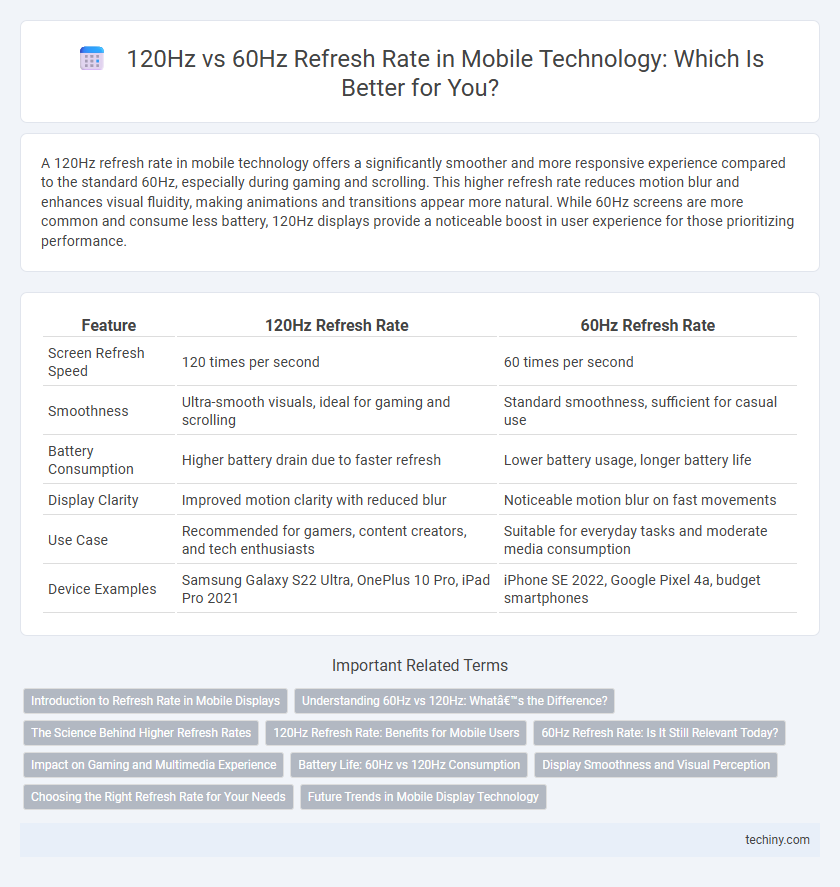A 120Hz refresh rate in mobile technology offers a significantly smoother and more responsive experience compared to the standard 60Hz, especially during gaming and scrolling. This higher refresh rate reduces motion blur and enhances visual fluidity, making animations and transitions appear more natural. While 60Hz screens are more common and consume less battery, 120Hz displays provide a noticeable boost in user experience for those prioritizing performance.
Table of Comparison
| Feature | 120Hz Refresh Rate | 60Hz Refresh Rate |
|---|---|---|
| Screen Refresh Speed | 120 times per second | 60 times per second |
| Smoothness | Ultra-smooth visuals, ideal for gaming and scrolling | Standard smoothness, sufficient for casual use |
| Battery Consumption | Higher battery drain due to faster refresh | Lower battery usage, longer battery life |
| Display Clarity | Improved motion clarity with reduced blur | Noticeable motion blur on fast movements |
| Use Case | Recommended for gamers, content creators, and tech enthusiasts | Suitable for everyday tasks and moderate media consumption |
| Device Examples | Samsung Galaxy S22 Ultra, OnePlus 10 Pro, iPad Pro 2021 | iPhone SE 2022, Google Pixel 4a, budget smartphones |
Introduction to Refresh Rate in Mobile Displays
Mobile displays with a 120Hz refresh rate offer smoother animations and more responsive touch inputs compared to traditional 60Hz panels by updating the screen image 120 times per second instead of 60. This higher refresh rate enhances the visual experience in gaming and scrolling, reducing motion blur and screen tearing. While 120Hz panels demand more power, they significantly improve fluidity and user interaction on smartphones and tablets.
Understanding 60Hz vs 120Hz: What’s the Difference?
A 120Hz refresh rate delivers smoother motion and more responsive touch input compared to 60Hz, enhancing gaming and video playback experiences on mobile devices. The higher refresh rate updates the display image 120 times per second, reducing motion blur and providing clearer visuals during fast movements. While 60Hz is standard and more power-efficient, 120Hz is preferred for improved fluidity and real-time interaction in modern mobile technology.
The Science Behind Higher Refresh Rates
A 120Hz refresh rate means the screen updates 120 times per second, delivering smoother motion and reducing motion blur compared to the standard 60Hz rate. This higher frequency enhances visual fluidity, especially in fast-paced gaming and video playback, by increasing frame responsiveness and decreasing latency. The ability to render more frames per second directly improves user experience by providing clearer, more detailed visuals and reducing eye strain.
120Hz Refresh Rate: Benefits for Mobile Users
A 120Hz refresh rate offers smoother animations and more responsive touch interactions compared to the standard 60Hz, enhancing gaming and multimedia experiences on mobile devices. Higher refresh rates reduce motion blur and improve visual fluidity, making scrolling and transitions appear more natural and less strenuous on the eyes. This advanced display technology benefits users by delivering superior screen performance, ultimately contributing to increased user satisfaction and engagement.
60Hz Refresh Rate: Is It Still Relevant Today?
A 60Hz refresh rate remains relevant today for users prioritizing battery efficiency and cost-effectiveness in mobile devices. While 120Hz offers smoother animations and enhanced gaming experiences, many daily applications like browsing and messaging perform adequately at 60Hz without noticeable lag. Smartphones with 60Hz displays continue to hold value in budget and mid-range segments, balancing performance and energy consumption efficiently.
Impact on Gaming and Multimedia Experience
A 120Hz refresh rate significantly enhances gaming and multimedia experiences by delivering smoother motion and reduced input lag compared to the standard 60Hz. High refresh rates improve responsiveness in fast-paced games, providing competitive advantages and immersive gameplay with fluid animations. Multimedia content, including video playback and animation, appears more seamless and visually appealing, elevating overall user engagement on mobile devices.
Battery Life: 60Hz vs 120Hz Consumption
A 120Hz refresh rate significantly increases power consumption compared to 60Hz, leading to faster battery drain on mobile devices. Devices operating at 60Hz refresh rate typically achieve longer battery life, making them more efficient for extended usage. Optimizing refresh rate settings or using adaptive refresh technology can balance smooth performance and battery longevity.
Display Smoothness and Visual Perception
A 120Hz refresh rate doubles the number of screen updates per second compared to a 60Hz display, resulting in significantly smoother motion and reduced blur during fast-paced content like gaming or video playback. Enhanced display smoothness at 120Hz improves visual perception by minimizing flicker and motion judder, leading to a more immersive and comfortable user experience. This higher refresh rate provides greater responsiveness and fluidity, critical for applications requiring precise touch input and quick visual feedback.
Choosing the Right Refresh Rate for Your Needs
Choosing the right refresh rate depends on your usage and device capabilities. A 120Hz refresh rate offers smoother animations and improved responsiveness, ideal for gaming and high-frame-rate video playback, while a 60Hz refresh rate conserves battery life and is sufficient for casual browsing and standard media consumption. Consider the balance between performance and power efficiency to select a refresh rate that best matches your mobile technology needs.
Future Trends in Mobile Display Technology
A 120Hz refresh rate doubles the frame updates per second compared to 60Hz, resulting in smoother animations, reduced motion blur, and enhanced responsiveness in mobile displays. Future trends in mobile display technology emphasize ultra-high refresh rates beyond 120Hz, adaptive refresh rate mechanisms for power efficiency, and integration with 5G for improved multimedia experiences. This evolution supports immersive gaming, seamless scrolling, and advanced user interfaces, setting new standards for mobile visual performance.
120Hz refresh rate vs 60Hz refresh rate Infographic

 techiny.com
techiny.com